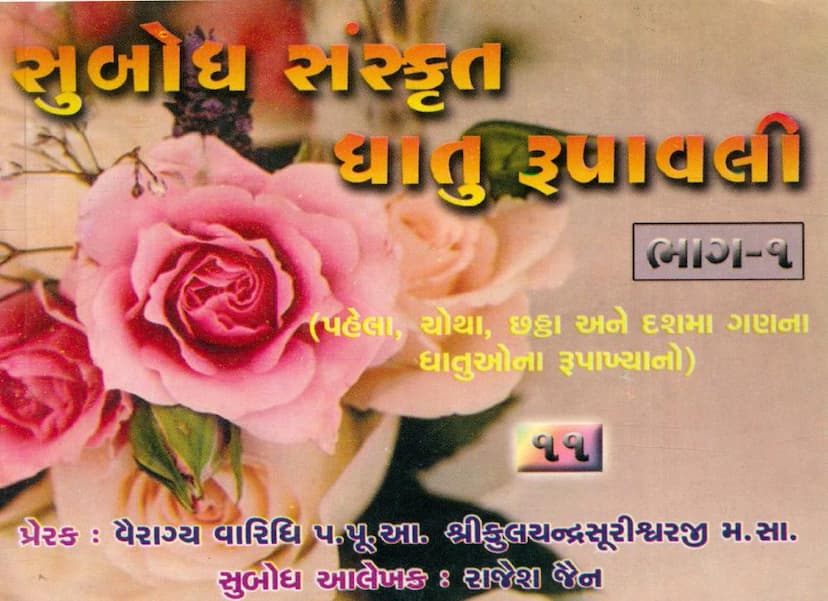Subodh Sanskrit Dhatu Rupavali Part 01
Added to library: September 2, 2025

Summary
Here's a comprehensive summary of the Jain text "Subodh Sanskrit Dhatu Rupavali Part 01" by Rajesh Jain, published by Tattvatrai Prakashan, based on the provided content:
Book Title: Subodh Sanskrit Dhatu Rupavali Part 01 (સુબોધ સંસ્કૃત ધાતુ રૂપાવલી ભાગ - ૧) Author: Rajesh Jain Publisher: Tattvatrai Prakashan
Core Purpose and Content:
This book is a foundational guide to understanding Sanskrit verb roots (dhatus) within the framework of Jainism, specifically focusing on the first, fourth, sixth, and tenth grammatical classes (ganas) of Sanskrit verbs. It aims to provide a "subodh" (easy to understand) approach to learning these conjugations.
Key Features and Structure:
- Grammatical Focus: The primary objective is to present the conjugation (rupākhyānas) of Sanskrit verb roots belonging to specific grammatical classes.
- Structure: The book is divided into several chapters:
- Chapter 1: Focuses on the suffixes (pratyayas) used for conjugating roots from the first four ganas (first, fourth, sixth, and tenth). It also introduces the "vikaran pratyaya" (augmenting vowels) specific to each of these ganas.
- Chapter 2: Deals with "Paramapad - Kartari Prayog" (Parasmaipada - Active Voice), presenting the conjugations for roots from the first, second, fourth, sixth, and tenth ganas.
- Chapter 3: Covers "Ātmanepad - Kartari Prayog" (Ātmanepada - Active Voice), detailing conjugations for roots of the first, fourth, sixth, and tenth ganas.
- Chapter 4: Focuses on "Karmaṇi Prayog" (Passive Voice).
- Chapter 5: Presents the conjugations of roots from the first, fourth, sixth, and tenth ganas in all four tenses (kālas) and their derivative forms (krdantas).
- Comprehensive Verb Forms: The book systematically details various verb forms including:
- Present Tense (Vartamāna Kālas)
- Imperfect Tense (Hastana - Anadyatana - Apurna Bhutkal)
- Imperative Mood (Ājnārtha)
- Potential Mood (Vidhyartha)
- Active Voice Participles (Kartari Krdanta)
- Passive Voice Participles (Karmaṇi Krdanta)
- Gerunds (Hetvartha Krdanta)
- Past Passive Participles (Karmaṇi Bhuta Krdanta)
- Absolutive Participles (Sambandhaka Bhuta Krdanta)
- Jain Context: The book is presented within a Jain spiritual and educational context, with dedications and inspirations from respected Jain Acharyas and Munis. The publication is noted to be a "jnāndravya" (knowledge as a valuable possession) made available through the efforts of the Shri Koladungri Jain Sangh.
- Pedagogical Approach: The title "Subodh" suggests an emphasis on clarity and ease of understanding, making it suitable for learners of Sanskrit, particularly within the Jain tradition.
- Reference to Other Works: It references "Subodh Sanskrit Margopadeshika" for specific grammatical rules related to root augmentation (gunavrddhi).
Inspiration and Dedication:
The book is dedicated to the spiritual lineage of prominent Jain monks, including Acharya Shri Kulechandrasurishwarji Maharaj and his disciples, highlighting the spiritual motivation behind its creation and dissemination.
Availability and Distribution:
The book lists several "praptisthan" (places of acquisition) in Gujarat, India, including locations in Dholka and Unjha, and a publishing office in Mumbai. There is a note regarding its distribution, indicating it is for study purposes and that contributions to the "jnānakhaata" (knowledge fund) are appreciated for obtaining copies.
Overall Significance:
"Subodh Sanskrit Dhatu Rupavali Part 01" serves as a valuable resource for students and scholars of Sanskrit, especially those within the Jain community, who wish to master the grammatical structures of Sanskrit verbs. It simplifies the complex topic of verb conjugations, making it accessible and practical for learning. The book underscores the Jain emphasis on knowledge dissemination and spiritual development through learning.